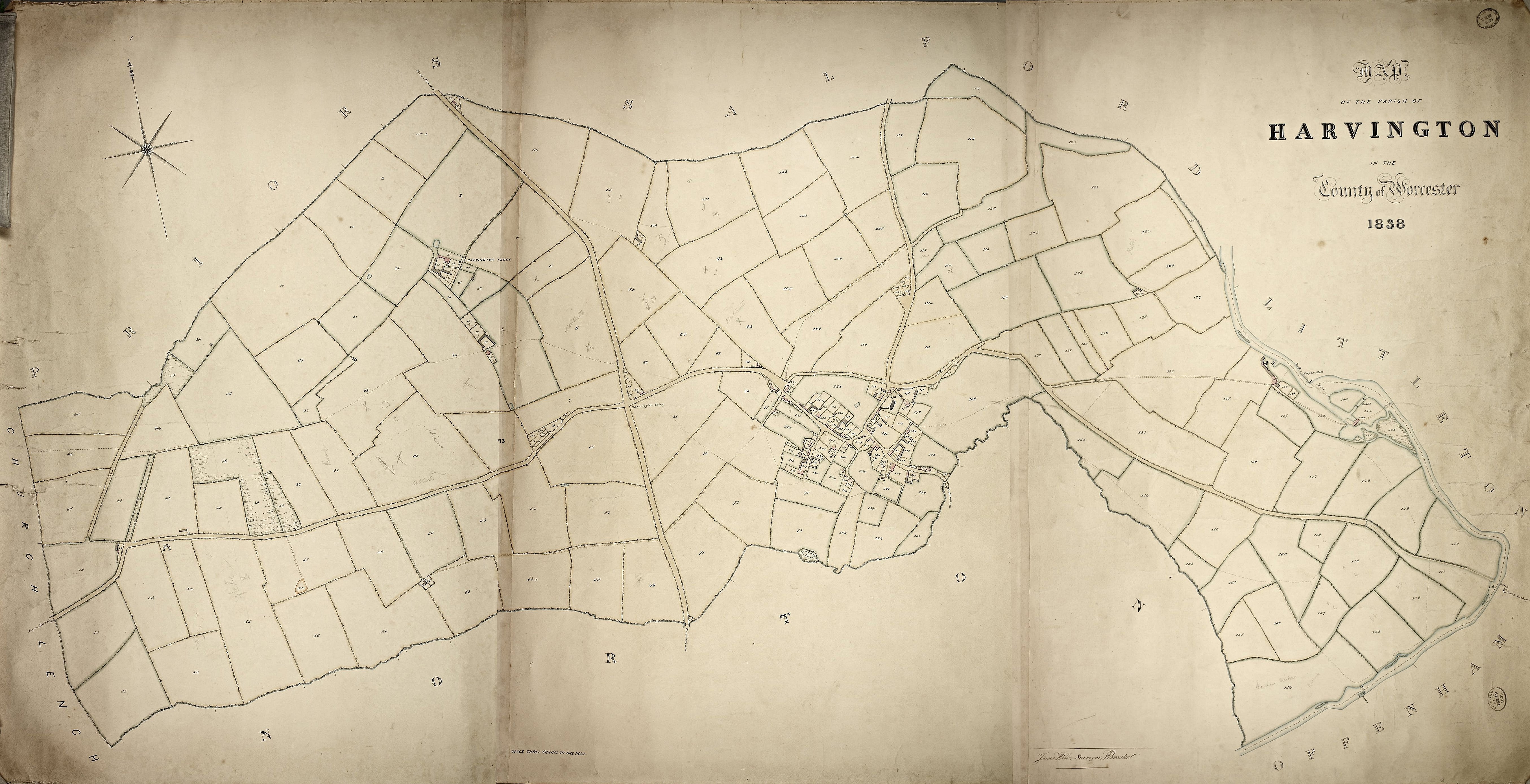
|
|
1838 TITHE MAP OF HARVINGTON
|
|
The above tithe map of Harvington (Worcestershire Record Office reference BA491), dated 1838, is a Manorial document. Harvington was owned by Worcester Cathedral and therefore came under the control the Dean & Chapter of Worcester. The map is on cloth and is approximately 6ft x 3ft, in good condition and shews Harvington's properties, fields, roads and river in fine detail. Those buildings depicted in pink are residential while those in grey are church, out- or farm buildings. Additions like footpaths and the occasional 'Allotment' are to be noted in pencil.
Each property and field has a number which referred to an accompanying 'Apportionment' Schedule, which would have shown who owned or rather occupied Harvington in 1838. Unfortunately, this all-important document has not been traced so we are at present left with the numbers without the key. In an attempt to overcome this loss, a schedule of the numbers on the map, indicating whether field, building etc., plus in time, additional information such as the tenant, has been created. It has already been possible to some extent to recreate, in part, the original through consulting other documents. A document amongst Deeds of Bank House relates to the sale of Bank House in 1870, see under Bank House in Houses. At the bottom of one of the pages is a chart of lands held by Bank House, albeit in 1870. The references in the document uses refer back to those used in the 1838 plan.
This map is so fine and has such detail with its numbered plots, it has been decided to use the map as a location base for the website as a whole.
Julian Rawes, Crooked Walls, 2015.
|
|
TITHE MAPS
|
|
Tithe, estate maps and early OS maps are a wonderful window into the past. Both served different purposes, two financial and one military. The map we are concerned with here is a Tithe map. There is much social history behind the creation of tithe maps and much has been written about them and the Enclosure Acts for which they were created.
Instead of attempting to go into the depth of detail that I don't have, I have lifted from the website of the Jesus Christ and Latter-Day Saints Church Archives site familyseach.org on Enclosure Records, an excellent article on the background to the reasons as to why these maps were created.
The enclosure movement was that process by which the common fields, shared pastures and scattered strips of arable land which made up the rural landscape of Mediaeval England gave way to the hedged fields and consolidated farms (Beech) of the 19th century. There was a national benefit in that agricultural productivity increased, but larger farmers benefited the most as smaller freeholders were often eased out in the process.
From 1235 manorial lords were allowed to enclose, with hedges, ditches, fences and stone walls, certain common land for arable or grazing purposes. This was known as assarting and meant that other parishioners no longer had common rights such as pasturage, pannage (letting pigs feed on acorns and beech-mast) and collection of wood etc. on these pieces of land (see TNA research guide D74). This system worked well on manors with large commons and wastes (moorland, woodland and marshland) because sufficient common lands survived. It obviously wasn’t popular in the largely arable open-field Midlands where commons were much smaller, and the large land-owners were keen on rearing more profitable sheep on the enclosed lands, thus displacing the people. Tate (The Parish Chest, 1983) has an excellent chapter on how the open-field system actually worked and how it was modernized by enclosure, and Hindle (Maps for Historians, 2002) has a discussion and good illustrations. Hollowell (Enclosure Records for Historians, 2000) is a detailed study of all types of enclosure, with many original examples and transcriptions, information about the process, the surveyors, their methods and the issues surrounding enclosure. The protest movement which resulted in much detail about participants in local newspapers, is detailed by Hugh Ward (Heroes or Villains? Family Revelations in Local Newspapers. Practical Family History Vol41, page 23-24.).
Even by Elizabethan times (1558-1603) much land had been enclosed by amalgamation of strips by common consent, thus allowing farming of land in severalty (independently of others). Closely associated with enclosure is the consolidation of two or more farms into one holding, known as engrossing.
From the 16th century landlords were allowed to enclose arable land for pasturing sheep, cattle or deer. From 1601 a series of individual private or local governmental Enclosure Acts allowed owners of 75-80% of the parish land to force enclosure (inclosure was the legal term). Enclosure commissioners were appointed to reallocate land in the parish by acreage and quality to named land-owners, farmers and graziers; ordinary tenants and labourers are not mentioned in the records.
From the mid-18th until the mid-19th centuries freeholders in most parishes in England and Wales were formally allowed to amalgamate their dispersed strips by exchange or purchase into more efficient farming units, as in this example quoted by Tate:
2 March 1765. Steeple Aston, Oxfordshire, Vestry Book
(punctuation added)
It [is] agreed to change land in the Dean by Willm Wing, Richd Prentice and Richd Fox, for Willm Wing to have Richd Fox piece above the stile for his piece below, and for Richd Prentice to have three lands of Richd Fox next to his land under the Dean hedge shooting into Short Clay Furlong for his two lands in the Dean and for six years at Saint Micahill next. By we
W. Wing, Richd Fox, Richd Prentice
The General Enclosure Acts of 1801, 1836 and 1845 eased the process but individual acts of parliament were needed; the legislation did not affect Ireland or Scotland. A rough guide to the main enclosure of counties by date is given below (from Hey).
Another website that should be consulted is that of the British Library.
|
|